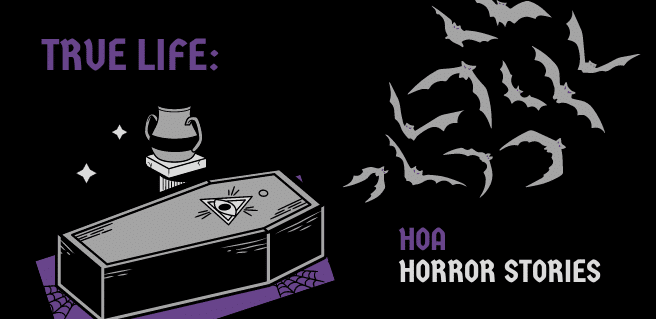From owners trashing properties to unnecessary legal problems, community association managers sometimes find themselves in troubling situations. In the spirit of Halloween, we are sharing a few spine-tingling HOA horror stories that actually happened (cue the spooky music)! Luckily, we’re also sharing tips on how you can avoid the frightening fates of these owners to enjoy a not-so-scary homeownership experience!
Special Assessment Of $7,500 Three Days After Closing!
A newlywed couple purchased a Buckhead condominium as their first home. Amid the excitement, they failed to read the condominium board meeting minutes about the $850,000 construction defect issue that required a repair. Unfortunately, their Realtor also had not read these notes and was unaware of this information. If either party had been more proactive, they would have known that each owner was responsible for a $7,500 payment for a special assessment. It was widely stated for months before this couple purchased their home, but they didn’t read the legal documents for their purchase that came from the closing attorney. As a result, they didn’t know about the assessment until the first board meeting — three days after they closed.
Tip: Read the board of directors meeting minutes to help uncover potential assessments or other issues. Be sure your Realtor understands condominium law. This will ensure that you are made aware of all important details and information before making the big decisions.
Owner Must Remove Fence And Koi Pond That Was Never Approved!
An avid gardener decided to install a new fence and decorative pond on his property in Sandy Springs, an investment that he believed would enhance the property value. This owner belonged to a homeowners association, but he failed to get written approval before starting the project. The work garnered the attention of several neighbors, one of whom sat on the board and knew the required paperwork had not been submitted. Soon after, a legal dispute began between the HOA and the owner, who claimed the board had not approved other ACC projects in the community. Consequently, the owner lost the case, and he was forced to remove the installations. He eventually sold the home, but not before leaving dead koi fish on the front steps of each of the board members’ homes.
Tip: Remember to read the covenants and ACC guidelines before starting any exterior modification to your property. Most associations require written approval by the board or ACC committee. By doing so, you’ll be able to prevent wasted efforts and complete projects without hitting any bumps along the way!
Buying A Rental Property That You Cannot Rent!
Many communities are limited on the number of rental units that are allowed in the property. Once that threshold is exceeded, no other owners can rent out their units until other units are sold and a leasing permit becomes available.
In this example, an owner in Atlanta put down $20,000 cash on a condo but didn’t read the CC&Rs. She closed escrow on a $100,000 unit that she planned to lease out. Unfortunately, the board blocked her from doing so because of the rental rules in the CC&Rs. She hired an attorney to sue the association and the management company, but the case was rejected. Unfortunately, she lost the unit due to foreclosure 12 months later.
Tip: Read CC&Rs to understand property restrictions. A simple request to the board or management company would have uncovered the problem, and this owner could have terminated her purchase contract and saved $20,000!
Pool, Clubhouse, Common Facilities Foreclosed Upon!
Lastly, this story is about a Gwinnett County HOA. At this property, the developer built the residential units on one lot and placed the clubhouse, pool and common areas on a separate lot. The pool/clubhouse lot had a separate loan that went into default, and an investor group bought the lot with the pool and clubhouse at foreclosure. As a result, they began selling pool memberships to community members in the adjacent neighborhoods.
At a Fourth of July pool party where drinking occurred, individuals from the different neighborhoods began arguing over the issue and a major fight began. Others joined the brawl, and several people were injured before the local police arrived and made arrests for disorderly conduct. In addition, several beer bottles were broken during the fight and glass shards landed in the pool. The HOA had to drain the water, vacuum the bottom and refill the pool at great expense. They ultimately charged the owners who caused the damage, but they declined to pay and hired an attorney to fight the case. The matter is still in legal negotiations.
Tip: In this case, the individuals should have read the community governing documents, which would’ve revealed the recorded map, plat, or plan for the community. It’s also important to determine if the HOA owns the amenities.
Moral of the Stories
Keep in mind that many of these situations could have been avoided if the owner had performed proper due diligence. Living in an HOA doesn’t have to be a scary situation if rules and regulations are understood and followed. Owners should always review the HOA documents, financial statements, reserve studies and CC&Rs before purchase (and after) to avoid their own HOA horror story!
For more information on association management, visit www.BeaconManagementServices.com.
Read more news from Beacon Management Services by clicking here.
